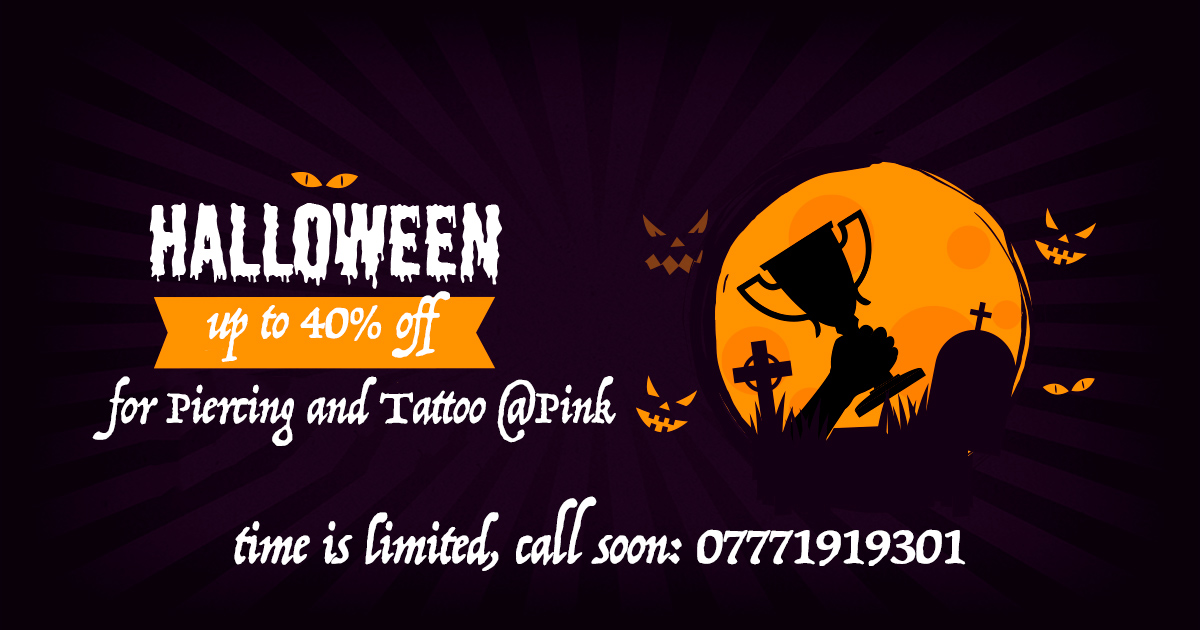Living with chronic migraines can be a debilitating experience, leading many to explore every possible avenue for relief. In recent years, you may have heard whispers in online forums or seen articles about the daith piercing as a potential, alternative aid. At Pink Tatpier, our London-based specialists are experts in performing this precise and technically demanding piercing. More importantly, we believe in providing an honest, expert-led guide to what this piercing is, the theories behind its connection to migraines, and what you can realistically expect.
This page is designed to separate scientific fact from anecdotal hope. We want to empower you with clear, transparent information so you can make a decision that is right for you—both as a piercing enthusiast and as someone seeking relief.
Crucial Disclaimer: It is important to state at the outset that while many clients anecdotally report a reduction in the frequency or severity of their migraines after getting a daith piercing, it is not a scientifically proven medical treatment. There are currently no large-scale clinical studies that validate this effect. This guide is for informational purposes about the piercing procedure itself.
We offer expert, precise placement based on acupressure theories, a transparent price, and a safe, professional environment. Book a consultation to discuss the piercing process with our London specialists
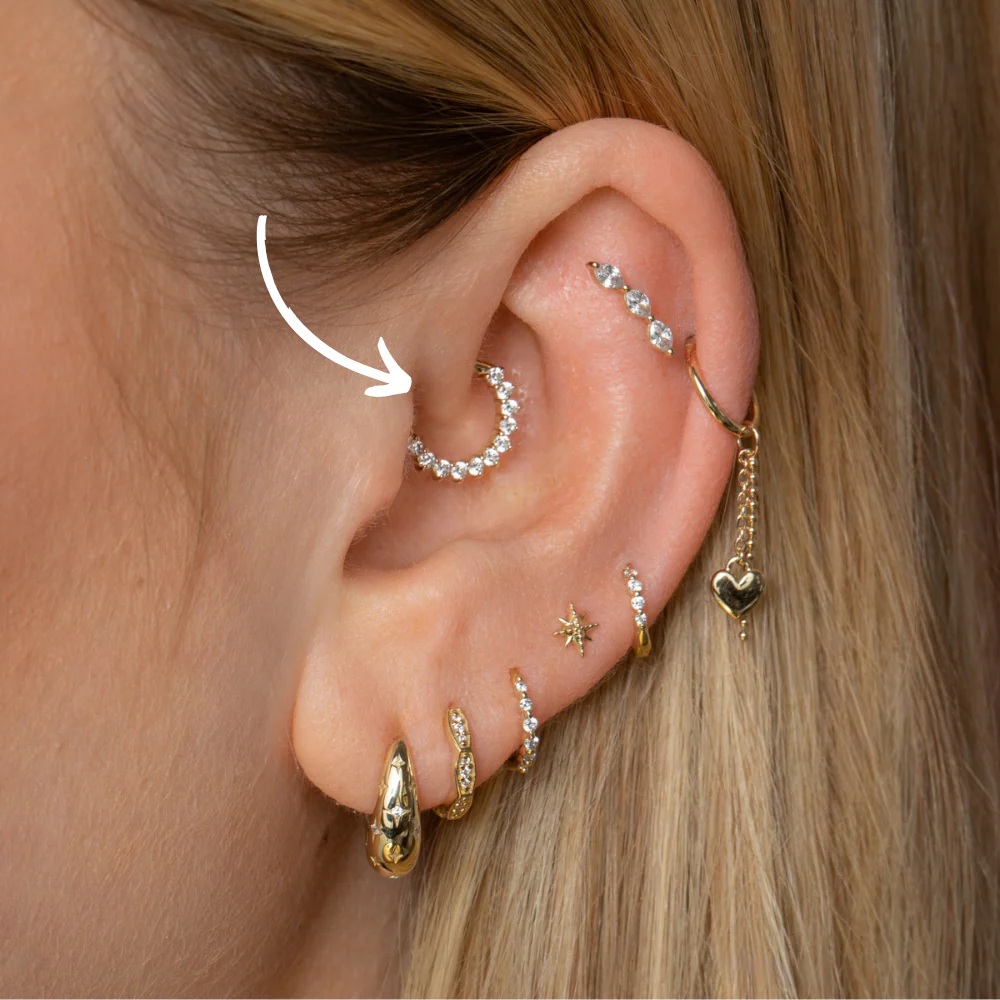
Daith Piercing
The Daith Piercing and Migraines: Separating Anecdote from Science
To make an informed decision, it’s essential to understand the full picture. Why did this connection between a cartilage piercing and migraine relief emerge, and what does the science say?
The Acupuncture & Vagus Nerve Theory
The theory linking the daith piercing to migraine relief is rooted in the ancient practice of acupuncture. The location of the daith piercing corresponds with a specific pressure point (often known as “Point Zero”) within the ear that acupuncturists stimulate to alleviate chronic headaches and migraines.
The idea is that a piercing in this exact spot provides constant, targeted pressure on this point. This is thought to mimic the effects of an ongoing acupuncture session. Furthermore, this area is a pathway for branches of the Vagus nerve, a major cranial nerve that plays a role in a wide range of bodily functions, including pain signals. Stimulating this nerve is a known medical approach for treating various conditions, and the theory suggests the piercing may provide a similar, mild stimulation.
The Powerful Anecdotal Evidence
It is impossible to ignore the thousands of personal stories from people worldwide who claim to have experienced significant relief after getting a daith piercing. Sufferers have reported everything from a complete cessation of migraines to a dramatic reduction in their frequency and intensity. This powerful anecdotal evidence is the primary driver of the piercing’s popularity.
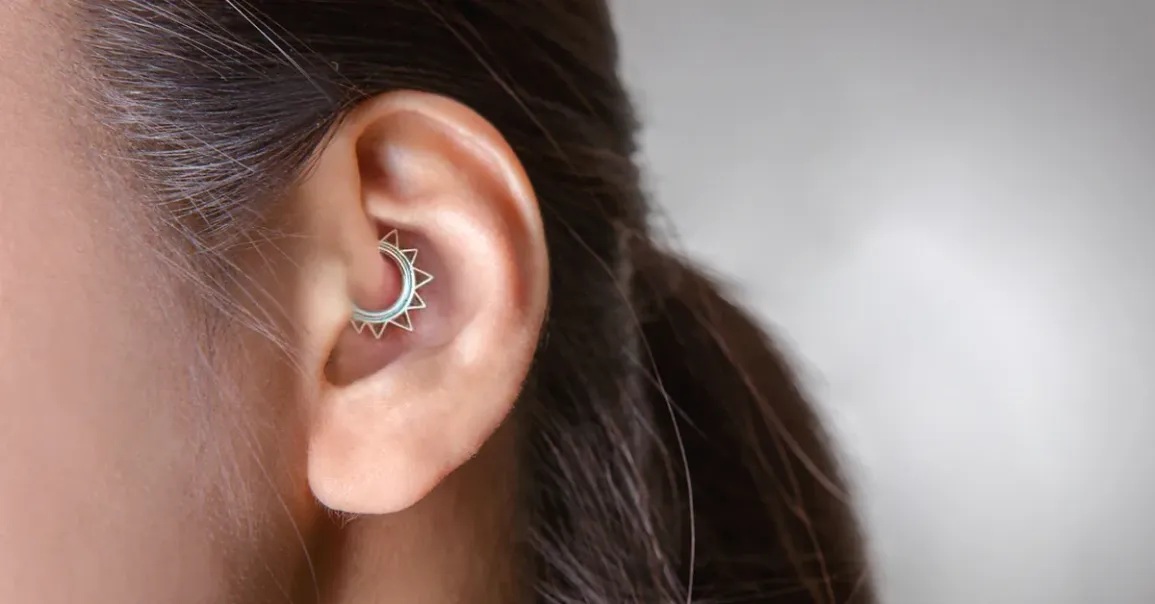
Daith Piercing
The Scientific View & The Placebo Effect
Currently, the medical community has not validated these claims through large-scale, peer-reviewed clinical trials. Many medical professionals attribute the reported relief to the placebo effect. The placebo effect is a real, documented phenomenon where a person’s strong belief in a treatment can cause real, physiological changes and symptom relief. It’s important to note that relief experienced via the placebo effect is still genuine relief.
Our Professional Stance at Pink Tatpier
Our role is not to offer a medical cure. Our role as professional piercers is to perform a beautiful, precise, and safe daith piercing. We encourage you to approach this with a balanced perspective: get the piercing primarily because you love its aesthetic. View it as a stunning piece of ear jewellery that may have an added, though unproven, benefit. If it helps your migraines, consider it a wonderful bonus. If it doesn’t, you are still left with a beautiful, expertly-placed piercing.
Why “Expert Placement” is Crucial for a Daith Piercing
The term “expert placement” is key. The technical execution of a daith piercing is one of the most challenging in the piercing world.
- Complex Anatomy: It is performed on the crus of the helix, a small and curved piece of cartilage deep within the ear. An expert piercer needs a deep understanding of ear anatomy to get the angle and position right so that it heals properly and sits beautifully.
- Alignment with Acupressure Points: Our experienced piercers are knowledgeable about the commonly referenced acupressure point. We take great care to place the piercing precisely in this location, ensuring that if there is a potential therapeutic benefit to be had, the piercing is in the optimal position to achieve it.
The Daith Piercing Process: A Safe and Precise Procedure
- Consultation & Anatomy Check: Not all ears have a sufficiently defined cartilage ridge to safely accommodate a daith piercing. The first step is always a thorough assessment by our piercer.
- Jewellery Selection: You will choose your initial jewellery. For a daith, this is typically a Captive Bead Ring (CBR), a seamless hoop, or a curved barbell.
- Precise Marking: Your piercer will carefully mark the entry and exit points. This is a critical step for ensuring the piercing is straight and well-placed.
- The Piercing Procedure: The piercing itself is swift, using a sterilised, single-use, curved needle.
- Aftercare Briefing: We will provide you with a comprehensive aftercare plan to help you navigate the healing process.
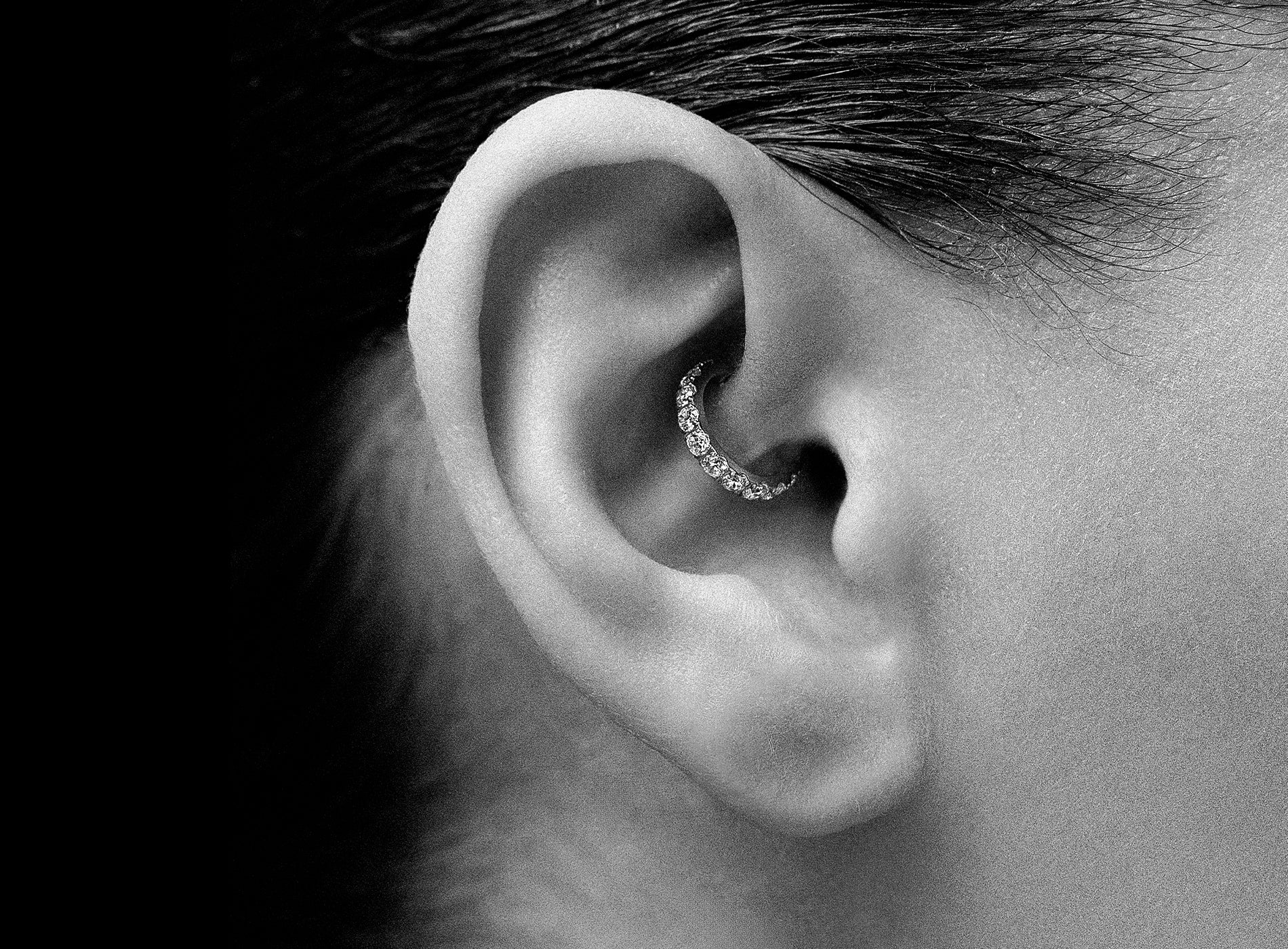
Daith Piercing
Daith Piercing Cost, Pain & Healing in London (2025 Guide)
Pain Level
Due to the thickness and sensitivity of the cartilage, the daith piercing is considered moderately painful. Most clients rate the pain at a 6-7 out of 10. It is a deep, strong pressure and a sharp pinch that is over very quickly. The area will likely feel tender and achy for a few weeks afterwards.
Healing Time
The daith is a protected piercing, but it is located in a tight space that can be difficult to keep clean. The healing time is long, typically 9 to 12 months, and sometimes longer. Consistent aftercare is absolutely essential.
Cost of a Daith Piercing in London (as of September 2025)
| Service | Price (GBP) | What’s Included |
| Daith Piercing Service Fee | £45 – £55 | A specialist consultation, in-depth anatomy assessment, expert placement, sterile piercing procedure, and a comprehensive aftercare guide. |
| Initial Jewellery | Starts from £25 | An implant-grade titanium hoop or curved barbell. Price increases for solid gold or gemstone options. |
| Total Starting Price | From £70 – £80 | The piercing fee + the cost of your chosen jewellery. |
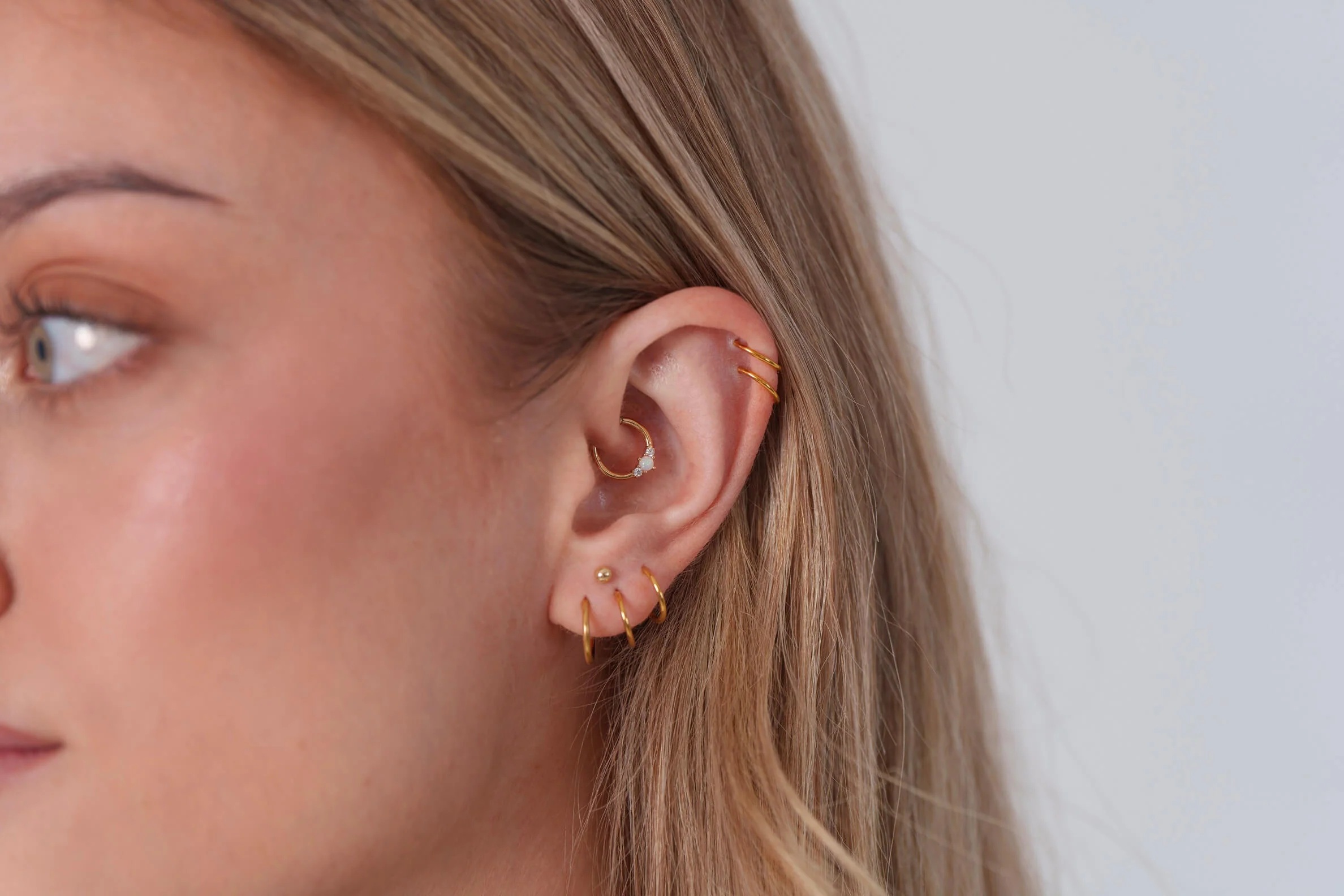
Daith Piercing
The Best Jewellery for Your Daith Piercing
For initial healing, the most common jewellery choices are:
- Captive Bead Rings (CBRs) or Hoops: The circular shape allows for easier cleaning and can accommodate swelling.
- Curved Barbells: Also a suitable option, especially for certain anatomies.
We exclusively use implant-grade, internally threaded or threadless jewellery made from Titanium (ASTM F-136) or 14k/18k Solid Gold to ensure a safe healing process free from allergic reactions.
Essential Aftercare for a Healthy Daith Piercing
- DO clean the piercing twice daily with a sterile saline solution.
- DO NOT use earbuds or AirPods in that ear for the entire healing period, as they will put pressure on the piercing and introduce bacteria. Over-ear headphones are the only suitable option.
- DO NOT twist, turn, or play with the jewellery.
- DO be careful when on the phone, and try to use the opposite ear.
- DO ensure the area is kept clean and dry, especially after showering.
Frequently Asked Questions About the Migraine Piercing
1. Which side should I get the daith piercing on for migraines?
The common anecdotal advice is to get it on the side where you experience the majority of your migraine pain. If your pain is generalised, some choose their non-dominant side for convenience (e.g., the side you don’t sleep on or use the phone with).
2. What if it doesn’t work for my migraines?
This is a possibility you must be prepared for. As stated, there is no guarantee. Our philosophy is that you should approach this as getting a beautiful piercing first and foremost. If it doesn’t affect your migraines, you are still left with a stunning, expertly-done piece of body art.
3. Is my ear anatomy suitable for a daith piercing?
This can only be determined during a professional, in-person assessment. If the cartilage fold is too small or shallow, a piercing may not be viable or may not heal properly. Our piercers will always give you an honest evaluation.
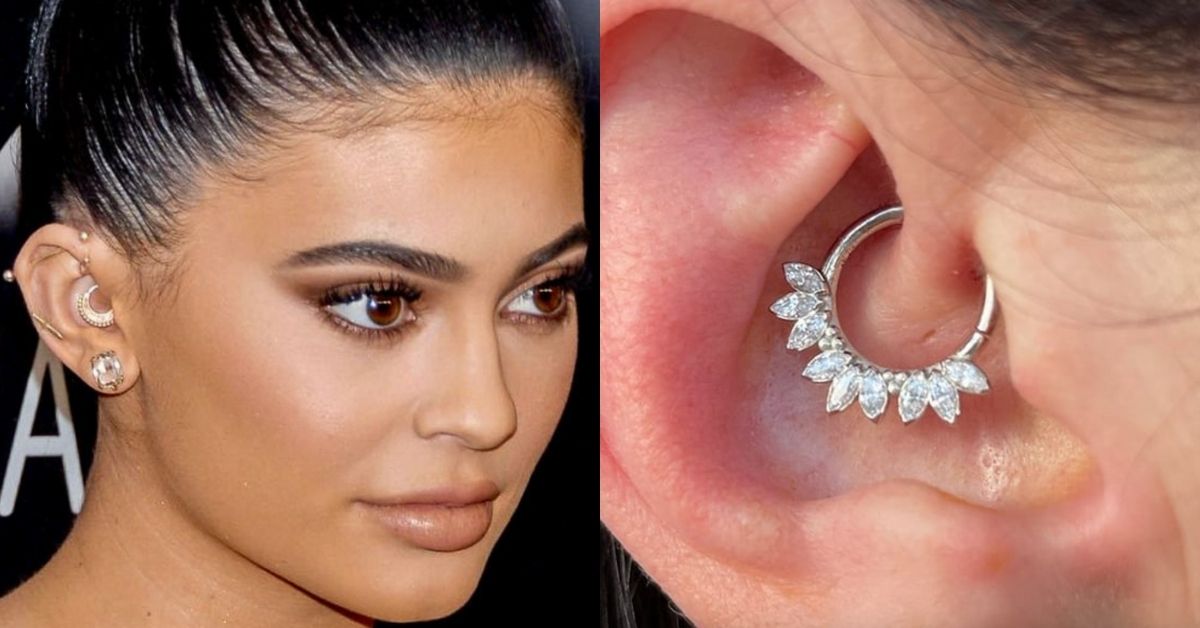
Daith Piercing
Explore the Daith Piercing at Our London Studio
Whether you are drawn to the daith piercing for its potential therapeutic benefits or purely for its striking aesthetic, the key to a successful outcome is choosing a skilled and responsible piercer.
We invite you to our London studio to discuss the process in a professional, no-pressure environment. Let us assess your anatomy, answer your questions, and help you make an informed decision.

